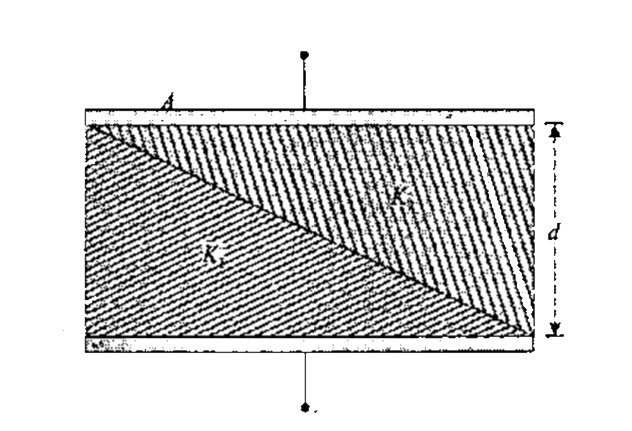There is an air filled 1pF parallel plate capacitor. When the plate separation is doubled and the space is filled with wax, the capacitance increases to 2pF. The dielectric constant of wax is
2
4
6
8
The correct Answer is:B
Step by step video, text & image solution for There is an air filled 1pF parallel plate capacitor. When the plate separation is doubled and the space is filled with wax, the capacitance increases to 2pF. The dielectric constant of wax is by Physics experts to help you in doubts & scoring excellent marks in Class 12 exams.
Related Playlists
- BOOK - PHYSICS GALAXY - ASHISH ARORACHAPTER - CAPACITANCEEXERCISE - ADVANCE MCQS26videos
CAPACITANCE
- BOOK - PHYSICS GALAXY - ASHISH ARORACHAPTER - CAPACITANCEEXERCISE - UNSOLVED NUMERICAL PROBLEMS40videos
CAPACITANCE
- BOOK - PHYSICS GALAXY - ASHISH ARORACHAPTER - CAPACITANCEEXERCISE - CONCEPTUAL MCQA32videos
CAPACITANCE
- BOOK - PHYSICS GALAXY - ASHISH ARORACHAPTER - ATOMIC PHYSICSEXERCISE - Unsolved Numerical Problems39videos
ATOMIC PHYSICS
- BOOK - PHYSICS GALAXY - ASHISH ARORACHAPTER - CURRENT ELECTRICITYEXERCISE - All Questions389videos
CURRENT ELECTRICITY
Knowledge Check
- Question 1 - Select One
There is an airfilled capacitor of capacity C. when the plate separation is doubled and a dielectric is introduced between the plates, the capacitance becomes 2 C. the dielectric constant of the dielectric is
A2B4C6D8 - Question 1 - Select One
An air filled parallel capacitor has capacity of 2pF. The separation of the plates is doubled and the interspaces between the plates is filled with wax. If the capacity is increased to 6pF, the dielectric constant of was is
A2B3C4D6 - Question 1 - Select One
When a parallel plate capacitor is filled with wax after separation between plates is doubled, its capacitance becomes twice. What is the dielectric constant of wax?
A1B2C3D4 - Question 1 - Select One
The capacitance of an air filled parallel plate capacitor is 10μF. The separation between the plates is doubled and the space between the plates is then filled with wax giving the capacitance a new value of 40×10−12 farads. The dielectirc consatnt of wax is
A12.0B10.0C8.0D4.2 - Question 1 - Select One
A parallel plate capacitor of area ‘A’ plate separation ‘d’ is filled with two dielectrics as shown. What is the capacitance of the arrangement ?
 A3Kε0A4dB4Kε0A3dC(K+1)ε0A2dDK(K+3)ε0A2(K+1)d
A3Kε0A4dB4Kε0A3dC(K+1)ε0A2dDK(K+3)ε0A2(K+1)d
Similar Questions
AN air filled parallel plate capacitor has a capacitance of 2.1 pF. The separation of the plates is doubled, and wax is inserted between them . The new capacitance is 2.6pF Find the dielectric constant of the wax.
View SolutionThe capacitance of a parallel plate capacitor with plate area A and separation d is C. The space between the plates in filled with two wedges of dielectric constants K1 and K2 respectively. Find the capacitance of resulting capacitor.
 View Solution
View SolutionThe capacitance of a parallel plate capacitor with plate area A and separation d is C. The space between the plates in filled with two wedges of dielectric constants K1 and K2 respectively. Find the capacitance of resulting capacitor.
 View Solution
View SolutionFigure shown a parallel-plate capacitor having square plates of edge a and plate-separation d. The gap between the plates is filled with a dielectric of dielectric constant K which varies parallel to an edge as K=K0+αx, where K and α are constants and x is the distance from the left end. Calculate the capacitance.
 View Solution
View SolutionA parallel plate capacitor, with plate separation d and plate area A, has a capacitance of 5μF. Calculate the new capacitance if the plate separation is reduced to 0.75d and the capacitor is completely filled with dielectric of dielectric constant 8.
View Solution

